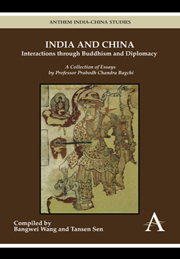 India and China: Interactions through Buddhism and Diplomacy
India and China: Interactions through Buddhism and Diplomacy Book contents
- Frontmatter
- Contents
- Compilers' Note
- Introduction (English and Chinese)
- Part One
- 1 Ancient Chinese Names of India
- 2 The Beginnings of Buddhism in China
- 3 Indian Influence on Chinese Thought
- 4 A Note on the Avadānaśataka and its Chinese Translation
- 5 Bodhisattva-śīla of Śubhākarasiṁha
- 6 A Fragment of the Kāśyapa Saṁhitā in Chinese
- 7 The Chinese Mysticism
- 8 Some Early Buddhist Missionaries of Persia in China
- 9 Some Letters of Hiuan-Tsang and his Indian Friends
- 10 New Lights on the Chinese Inscriptions of Bodhgayā
- 11 A Buddhist Monk of Nālandā amongst the Western Turks
- 12 Political Relations between Bengal and China in the Pathan Period
- 13 Chinese Coins from Tanjore
- 14 Report on a New Hoard of Chinese Coins
- 15 Ki-pin and Kashmir
- 16 Sino-Indian Relations – The Period of the United Empires (618–1100 A.D.)
- Part Two Short Articles
- Part Three Articles in Bengali
- Appendix
- Index
1 - Ancient Chinese Names of India
from Part One
Published online by Cambridge University Press: 05 March 2012
- Frontmatter
- Contents
- Compilers' Note
- Introduction (English and Chinese)
- Part One
- 1 Ancient Chinese Names of India
- 2 The Beginnings of Buddhism in China
- 3 Indian Influence on Chinese Thought
- 4 A Note on the Avadānaśataka and its Chinese Translation
- 5 Bodhisattva-śīla of Śubhākarasiṁha
- 6 A Fragment of the Kāśyapa Saṁhitā in Chinese
- 7 The Chinese Mysticism
- 8 Some Early Buddhist Missionaries of Persia in China
- 9 Some Letters of Hiuan-Tsang and his Indian Friends
- 10 New Lights on the Chinese Inscriptions of Bodhgayā
- 11 A Buddhist Monk of Nālandā amongst the Western Turks
- 12 Political Relations between Bengal and China in the Pathan Period
- 13 Chinese Coins from Tanjore
- 14 Report on a New Hoard of Chinese Coins
- 15 Ki-pin and Kashmir
- 16 Sino-Indian Relations – The Period of the United Empires (618–1100 A.D.)
- Part Two Short Articles
- Part Three Articles in Bengali
- Appendix
- Index
Summary
India is at present known in China under the name Yin-tu. This is not a modern adaptation. It goes back at least to the T'ang period. It seems to have been current slightly earlier, but the great Chinese pilgrim Hsüan-chuang was the first to baptise it. In his Hsi-yü Chi, while discussing the various Chinese names for India, he says:
“We find that different counsels have confused the designations of Tienchu (India); the old names were Shen-tu and Sien (or Hien)-tou; now we must conform to the correct pronunciation and call it Yin-tu. The people of Yin-tu use local appellations for their respective countries; the various districts having different customs; adopting a general designation and one which the people like, we call the country Yin-tu which means the Moon”.
It is clear from the statement that the Indians themselves had no popular general designation for the country as a whole and Yin-tu was a name used by the Chinese for the country. Hsüan-chuang as a great Sanskritist was keen on explaining the etymology of the names and hence explained the name Yin-tu (ien-duo>indu) as “moon”. In fact, as a Sanskrit word it (indu) can mean only “moon”. Hsüan-chuang also justified his explanation in an ingenious way:
“The unceasing revolutions of mortals' existence are a dark long night; were there not a warden of the dawn they would be like the night with its lights which succeeds the setting of the sun; although the night has the light of the stars, that is not to be compared to the light of the clear moon. […]
- Type
- Chapter
- Information
- India and China: Interactions through Buddhism and DiplomacyA Collection of Essays by Professor Prabodh Chandra Bagchi, pp. 3 - 12Publisher: Anthem PressPrint publication year: 2011


